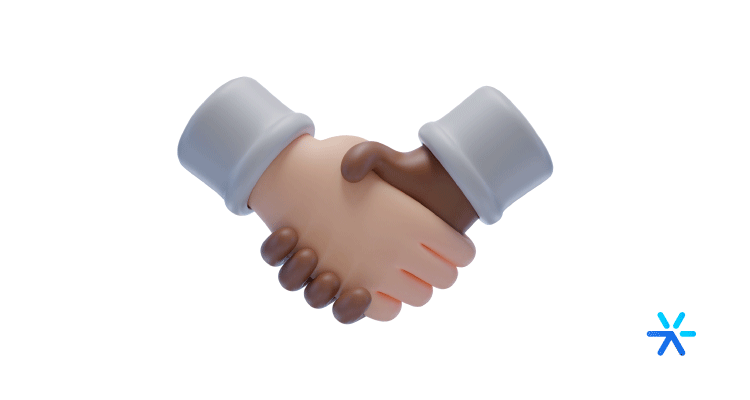Sales Playbook in practice: step by step + examples
The whole team working together in the way that works — if we could summarize the Sales Playbook in a single sentence, that would definitely be it.
A Sales Playbook is a document aimed at standardizing the work of a sales team to always seek the best possible results.
Commercial departments are always looking for new ways to work well with prospects and guarantee the best possible results in the semester. But this search cannot be individual, everyone for themselves.
Every sales team needs one. Is it urgent! It has the power to centralize all information related to sales, and carries within it all the practices tested and approved by the team over the years of its operation.
With this, everything that has worked so far can be replicated. And everything that can still work can be tested with formal and safe methods.
If you have a sales team but don’t have a Sales Playbook, this text is for you. Shall we understand more about him?
Starting from the basics:
What is a Sales Playbook?

The Sales Playbook is a document that guides the sales team’s efforts to generate more customers.
How this happens, however, is the big mystery.
Defining the Sales Playbook is simple, in one line we have already achieved it. In fact, in the introduction to this text it should already be clear to you what it does.
We can summarize the Sales Playbook as a manual . It is through it that all salespeople have access to the company’s best practices, its sales strategies, its integrated marketing efforts, its own sales techniques, etc.
The Sales Playbook is very necessary because a sales team cannot leave salespeople working on small islands , each doing what their heart tells them.
Everyone needs to work together and in a standardized way, so that it is possible to measure efforts and identify successful practices and repeat them.
The Sales Playbook provides information such as:
- Sales scripts ;
- Email templates ;
- Target audience and persona profile ;
- Negociation techniques ;
- Discounts allowed overall and by product;
- KPIs and targets determined by sales managers ;
- Customer pain ;
- Most common objections and how to get around them ;
- The Shopping Journey map ;
- The design of the Marketing and Sales Funnel ;
And whatever else is necessary to improve the work of the sales team.
But who prepares the Sales Playbook? Is it the company itself? Is it an outsourced professional? It all depends. Let’s talk about this now:
Who prepares the Sales Playbook?

Well, as we talked about, it really depends.
The Sales Playbook can be prepared by an internal team, with support or even direction from the sales team, or by a specialized consultancy company.
Most people who opt for consultancy do so because the Sales Playbook is a complex document, which involves information that goes far beyond sales.
And areas of expertise too.
And whoever chooses to prepare the document within the company is looking to save on investment while leading a collective team effort.
In any case, the decision to choose one method or another involves deeper organizational issues. Let’s talk about them now:
Internal Sales Playbook
The internal Sales Playbook must be prepared by an interdisciplinary committee involving people from different areas in your company.
It is not possible, for example, to leave the preparation to the sales team alone. And marketing efforts, how will they be described?
And who will develop the KPIs for monitoring, the OKRs, the goals?
The areas related to the Sales Playbook are marketing, sales, service and operational management.
Together, these areas are those that have the most direct contact with prospects , leads and customers. They are the ones that follow the entire life cycle of a person who buys from you.
Precisely for this reason, this committee needs to work together to prepare the Sales Playbook, preferably with the mentoring and review of the Sales Director.
The reality is a little different from this, however. Most companies that internalize the preparation of the Sales Playbook end up leaving everything in the hands of Sales Directors or Commercial Managers.
This is complicated because, despite this professional having a more 360° view of the sales processes, he still ends up putting himself in a very difficult position: doing it the right way and losing a few weeks (and even months) or accelerating production.
With accelerated production, it becomes very difficult to guarantee the quality of the final result.
This is why many companies choose to hire a consultancy. More on this below:
Outsourced Sales Playbook
The Sales Playbook prepared by outsourced professionals begins with consultancy.
Those responsible go to your company, get to know your sales process, your marketing, your management, your customer success department, etc.
Everything that impacts sales needs to be analyzed and measured.
Then, according to the information obtained, the outsourced company assembles the Sales Playbook and passes it on to the company.
This consultancy may or may not take time, it all depends on the current level of formalization of your routines.
Those who choose to outsource do so to guarantee the best possible result and also to avoid the work of putting together the Sales Playbook. And let’s face it: this is no small amount of work 😅
What is the importance of a Sales Playbook?

If you have a marketing team that is already generating leads, a sales team that is already selling a lot, it is natural to think about whether a Sales Playbook is really necessary.
It’s the classic “don’t touch a team that’s winning”. If everything is going well as it is now, why complicate it?
The truth is that this is the reason that frustrates most attempts to establish a Sales Playbook in any company.
In fact, it’s possible that this is your own problem. It is difficult to argue in favor of an initiative that will consume time and money without very clear possibilities for measuring the short-term return on investment.
If this is your situation at the moment, take the arguments below to your management . A Sales Playbook can have mainly long-term results, but they will never stop appearing.
Starting from the main:
Formalization of sales approaches
The seller Jonas offers a 10% discount on a sale for cash payment on Pix. And the seller Carlos offers a 15% discount for another sale, but it is the same product.
This is outside of a negotiation context: it is just a special condition for cash payment.
Jonas’s client, in this case, lost a 5% discount due to a lack of internal communication.
Or even in the negotiation itself: if each seller is offering something different, it ends up being up to the customer to navigate the payment conditions and variations in prices that each seller stipulates.
This is just a problem that the lack of formalization in sales approaches causes.
Another very classic: the seller Carlos only sends quotes by email. But Jonas sends it via WhatsApp. When a new salesperson arrives, the way they send their quotes will depend on who is doing their onboarding and training.
That’s a recipe for mess. Suddenly, the Commercial Director finds himself managing a team in which each salesperson does what he wants.
Measuring team efficiency goes down the drain in these cases. If there is no formalized practice, well-defined channels, standardized progressive discounts, etc., how do you know what works and what doesn’t?
And speaking of which:
Determining what works and what doesn’t
Many things in marketing and sales have a very well-defined formula, which when applied, brings great results.
But a lot of things also don’t have any formula: it’s what works in your segment and what works in your company, according to your target audience and their main needs.
A Sales Playbook seeks to formalize all the scenarios: what are the marketing and sales practices that bring in new sales, what are the customer success techniques that increase repurchases, and what are the “mysterious” tactics that work for no apparent reason in addition to the direct work of the seller.
This helps on several points. Firstly because it standardizes the best techniques, and secondly because it makes onboarding new employees simpler .
Very easy in training
Training is also much more valued when a Sales Playbook is involved.
This is one of the most ignored points in commercial teams. Those who don’t have a Playbook end up training new salespeople in the simplest way possible.
In other words: presenting the sales CRM , the company structure, the list of leads and that’s it — good luck!
And even outside the training period, the Playbook serves as the main document to resolve operational and negotiation doubts.
How much do I need to sell this month and why? The Playbook explains. What is my suggested and maximum discount? It’s on Playbook. Who am I selling to? It’s there too.
Any doubts that the beginner has will be resolved in the Playbook, which he already knows as it is his reference base in training.
As a result, the time for new salespeople to get used to the routines and start selling is drastically reduced.
And of course: from day one he has access to sales scripts created by the work of the best in the department.

Stimulating cooperation between teams
The Sales Playbook, as we have seen, is a multidisciplinary document.
He’s not just describing how the sales department works specifically.
In fact, it describes all the processes that will culminate in a sale. Here we include marketing techniques, service, customer success, after-sales and so on.
Because of this, the Sales Playbook will show the points of convergence between the teams, in addition to determining those ultimately responsible for each strategy.
This way, if you have any questions about leads, Playbook can answer them or refer you to the person who will help you in the marketing department.
As a result, the culture of cooperation between teams flourishes in your company. And this culture is essential for the most modern marketing and sales techniques to work well.
Optimization of the commercial process resulting in more sales
All of this has a direct impact on the amount of sales you make.
Of course, this result will not come in the short term. It’s very likely that while you’re putting the strategy to work, nothing will change immediately.
But the point is that the most sudden changes from one month to the next are more controlled. You are not so dependent on your salespeople, but on the entire commercial process.
How to create a Sales Playbook?
Creating a Sales Playbook is not that mysterious. In fact, it is quite simple to understand.
The complex itself ends up being the elaboration itself. All the information you need to look for, all the points you need to determine, and the act of sitting down to write the Playbook itself.
This, as we said, needs to be done together. It’s okay to have just one person writing and shaping the Playbook, but it needs to be done together.
Here we’re going to talk in more depth about how to build your Sales Playbook internally , taking advantage of your own team and without hiring any third party, ok?
This is because the outsourcing process is simple: you hire and that’s it.
But the internal elaboration is more complicated and needs to be very precise. There is a lot of time spent preparing the material, so you need to get it right the first time to avoid wasting resources.
Starting from the most basic point:
Determining the company’s operations and history
This point speaks directly to the new hires you will make.
Knowing the company is essential to be able to sell your products well. But much more than that.
Knowing his area of activity and the company’s trajectory, the salesperson immerses himself in the segment in which he operates, thus increasing his knowledge and ensuring more arguments for negotiation.
A customer may ask “but why should I buy from you?” The company’s history speaks for itself. It is possible to bring arguments that go beyond logic and enter the territory of emotion.
But telling the company’s story is just part of this chapter of the Sales Playbook. Information such as:
- Detailed information about the segment and market;
- Information about the competition;
- The company’s expansion strategy;
- Your Mission, Vision and Values;
- The hierarchical organization chart;
- The training calendar;
- Those responsible for each area;
- The responsibility of each seller;
Among other more specific points.
Determining how to represent the brand
How exactly should the brand be represented by its salespeople?
Here the Sales Playbook will determine what the contact points are like between the company and its customers, and how the interaction takes place exactly.
For example: what are the platforms on which the company prefers to approach customers? If Playbook determines that only through official channels, sellers cannot pass on their personal WhatsApp to customers.
Another point: are there specific words that the seller should avoid? Pejorative product names that should not be said, for example. Agricultural companies, for example, avoid the term “pesticides” and prefer “agricultural pesticides”.
This point needs a lot of support from marketing, especially the creatives who worked on creating the branding .
Do sellers want more freedom to create advertising pieces to send in bulk to contacts on the company’s WhatsApp? Great: check out the Sales Playbook on how to represent the logo, what fonts to use, where to find models, etc.
This point is quite important, but it is one of the most ignored. It is very rare to find any type of non-standard commercial communication in larger companies.
All because they value the Sales Playbook and understand the importance of standardizing the company’s message as it was imagined and approved by the board.
Promoting personas and ICP
The Sales Playbook also needs to contain information about your target audience and your ICP — Ideal Customer Profile .
ICP is a universal parameter that determines which customers are most likely to buy from you and, among those customers, which are the most valuable to your company.
The persona, in turn, is a creative exercise that seeks to place information from the ICP and the target audience in general into a fictional character.
The ICP determines the best market segment to be addressed by your strategy. While the persona gives a face and voice to this segment.
This information is crucial for new sellers. Through them, it is easy to understand how to approach new customers, what their main pain points are that the product solves, etc.
This makes negotiation and closing the sale much easier. Knowing who you are talking to in advance ensures a more empathetic and personalized approach.
The audience research that determines the ICP and persona is conducted by the marketing team. We have a whole text about this, check it out at the link below:
Determining KPIs
KPIs are the Key Performance Indicators of your marketing team and your commercial team.
Note that throughout the text we are always talking about these two teams mainly, right?
That’s because both play the biggest role in any company’s sales. While marketing is generating leads and qualifying them, the sales team works to close sales with the data and contacts that are arriving.
The KPIs of both teams need to be constantly monitored to avoid bottlenecks. Did the sales team perform poorly? The reason could be poor sales performance or a lack of marketing-qualified leads.
By determining KPIs, you can quickly measure what is happening, identify the bottleneck and act on it as quickly as possible.
Describing the commercial team
It is also important that the Sales Playbook describes who the sales team is.
This step is essential to ensure that everyone who enters the department understands its operating dynamics — who does what?
This will also allow for much greater team interaction, in addition to the correct division of responsibilities and a checkpoint for overworking.
Goal standardization
Goals should not come from anyone’s head. They need to be informed by the KPIs you create, which in turn should be informed by your OKRs.
The Sales Playbook must always keep goals updated, referencing the KPIs and OKRs so that everyone understands where the need to meet them comes from.
Arbitrary goals are complicated. When too high, they demotivate and stress your salespeople.
Likewise, when very low, they can motivate the team but are not adequate to maintain the viability of your business.
The only way to get it right is to calculate your goals according to KPIs. And since this calculation is being done, it doesn’t hurt to add them to the Sales Playbook, right?
Explaining the tools used and their integrations
This part becomes more important according to the maturity level of the company and its commercial process.
Very small companies generally use simple lead organization and call scheduling systems.
Midsize companies already have sales CRMs and integrations with marketing platforms, and use terms that can be quite complicated for junior salespeople — MQLs, SQLs, qualified leads, opportunities, SALs, PQLs, etc.
Meanwhile, large companies also use sales CRMs, but also very advanced Business Intelligence platforms, such as Power BI and applications like Salesforce.
The learning curve becomes steeper depending on the size of the company, but they all need to describe how these systems work in the Sales Playbook.
The reason is simple: security and time savings. You don’t want to lose sales due to poor use of the system, but you also don’t want the learning process to last weeks, right?
Disclosure of sales scripts
Finally, the Sales Playbook can also be responsible for determining the right way to sell.
This point is not universal: some companies leave their own salespeople to act according to their knowledge and skills.
But other companies prefer to have greater control over this process, and determine the order of offers, when to offer a discount, etc.
In this case, there is no better place to promote the script than the Sales Playbook. Through it, everything is formalized, and there is no risk of the seller using an outdated script.
How to share the Sales Playbook?
Well, now we are quite advanced in our text — in fact, we are reaching the end 🥲
With the information we’ve seen so far, you already know how to argue in favor of the Sales Playbook with your commercial management, whether it is better to internalize or outsource and, if internalized, how to prepare the document.
But knowing how to write the Sales Playbook is a point. Another, just as important, is understanding how it will be read.
That’s what we’re going to talk about now. First, let’s talk about the traditional, printed form. And then, about how to create a digital Sales Playbook, made by Notion.
Let’s go?
Printed Playbook
This is the most traditional way of promoting a Sales Playbook, but it is falling apart very quickly.
This is because a Sales Playbook cannot stand still in a modern digital marketing strategy.
You will always need to make changes. You will always need to add new data, update goals and report the evolution of KPIs.
On paper this is simply impossible: everything is recorded and remains the way it is until the next one is printed.
I myself recommend using software to document your Sales Playbook. See some recommendations below.
Software to formalize the Sales Playbook
The best software for writing the Sales Playbook are those aimed at the company’s internal documentation.
Notion , recently acquired by Atlassian, is a great example of this. It allows you to create huge documents divided into simple subcategories, with a similar functioning to the wikis we see around.
The interesting thing about Notion is that it comes with several ready-made and free-to-use templates, in the best Atlassian tradition of content dissemination — they do the same for Trello and Jira, for example.
Another solution is software aimed at technical product documentation , but they are more closed in their standard usability, making it difficult to use them for more malleable cases, such as the Sales Playbook.
Among this type of software, Document360 has been proving to be a great bet in the market, being simple to use and configure, and offering features similar to Notion, although more specific to the reality of software development.
In fact, many companies in the SaaS segment use the same documentation platform to create and edit the Sales Playbook. If this is your segment too, it’s a good idea to try to save money at this point.
Downloadable Sales Playbook Examples
To conclude the text, it is worth getting to know some Playbooks sold by brands that make them available for free.
These Playbooks, you will notice, are quite simple. They serve as a model to help you understand what yours needs to have, as well as guiding you through the structure of the chapters.
I put together a quick list here just so we can finish the text once and for all, ok? But stay with me and at the end I have one last message that will interest you.
Follow now a list of 4 Sales Playbook examples to download:
➡️ Forbes Sales Playbook Template;
➡️ Zendesk Sales Playbook Template ;
➡️ Sales Playbook ready from thoughtbot ;
I really hope that this text helped you to better understand the Sales Playbook and helped you a lot in preparing it.
But we need to talk about one last point, one that we even started talking about throughout the text — the need to adapt to changes.
Everything changes all the time in the world, to quote Lulu Santos. Your Playbook needs to undergo constant updates, as contemporary marketing is also constantly evolving.
We have material to help you understand everything that is in this state of change — it is the Future of the B2B Consumer.
In it, we bring together the main theories and hypotheses about the future of this type of business, and present everything in a simple, but very detailed way.
Download it for free today by clicking on the banner below — I’ll be waiting for you! Thanks for reading and we’ll see you in the next text 😉








